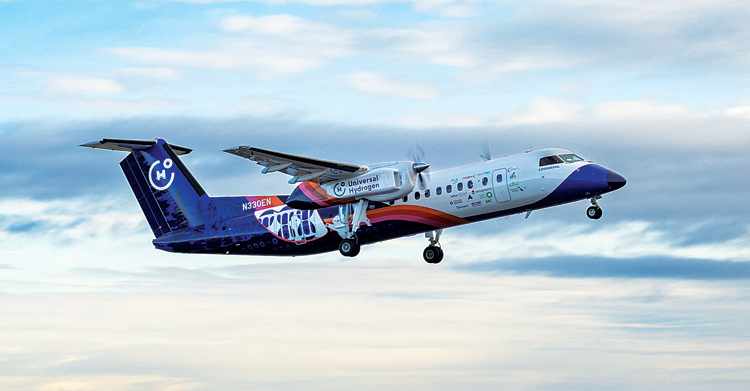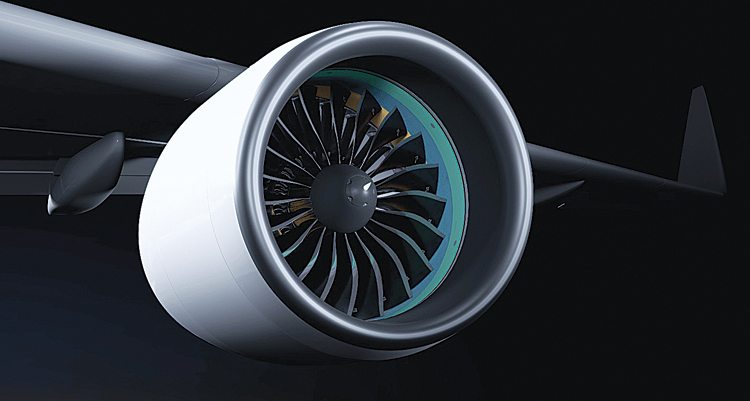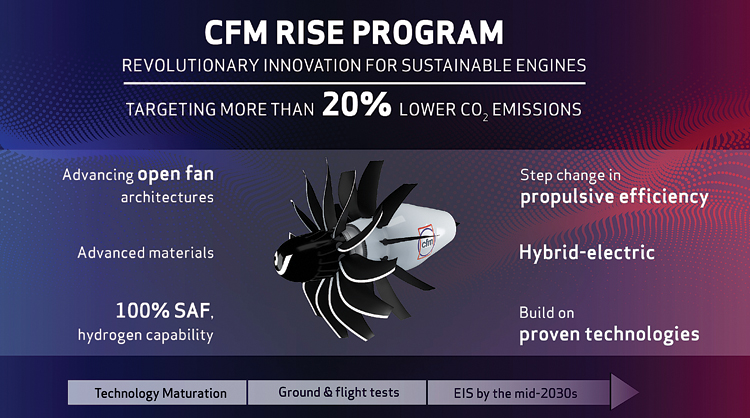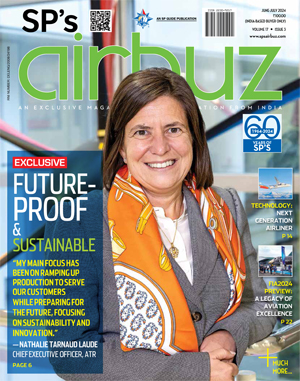The Next Generation is Coming!
Aeroengine makers today face a bewildering range of technological options for their next generation products – going all the way from simple upgrades of conventional designs to exotic configurations like the open fan to hybrid-electric installations to hydrogen-burning ones

The commercial aviation industry today is under growing pressure to go green. Although it accounts for just 2.4 per cent of global carbon dioxide (CO2) emissions, its relative share of emissions is projected to at least triple by 2050 as traffic surges and other sectors of the economy successfully decarbonise. The industry is committed to achieving net-zero carbon emissions by 2050, that is, completely eliminating or at least offsetting its emissions by then. This hugely challenging goal is heavily dependent on progress in the use of sustainable aviation fuels (SAF) and on the transition to more fuel-efficient passenger aircraft. Although SAF production is projected to increase rapidly it is still very expensive, and at present constitutes just one per cent of worldwide jet fuel use.
Most of the world’s passenger planes are built by a handful of manufacturers – notably Airbus and Boeing. And just three manufacturers produce the jet engines that power these airliners – General Electric Aerospace (GE), Pratt & Whitney and Rolls-Royce. These three, together with their joint ventures, enjoy close to 100 per cent market share. Within the past few years, all have launched major projects to increase fuel efficiency, with a strong focus on new technologies.
THE CURRENT SCENE
When it comes to fuel efficiency, CFM International, a 50-50 joint venture between two of the world’s leading aerospace companies – GE Aerospace and Safran Aircraft Engines – has been in the forefront of technological advancement for over 40 years. The CFM International LEAP engine, introduced into commercial service in August 2016, is 15 per cent more fuelefficient than the erstwhile top-of-the-line CFM56-5B and -7B engines. GE enjoys around 55 per cent market share when CFM products (which are built mainly to power narrowbody aircraft) are included. Of this, 16 per cent is attributable to GE alone.
Pratt & Whitney holds 26 per cent market share and focusses mainly on engines for narrowbody aircraft. The Pratt & Whitney PW1000G family, also called the GTF (geared turbofan) engine, was introduced in commercial service in January 2016, and is around 16 per cent more fuel efficient than the previous generation.
Acutely conscious of the need for greater fuel efficiency, engine manufacturers are engaged in an unending cycle of upgrades
Rolls-Royce is in third place, and holds 18 per cent market share. It focuses exclusively on engines for the widebody segment where its Trent XWB engines occupy pride of place.
Acutely conscious of the need for greater fuel efficiency, engine manufacturers are engaged in an unending cycle of upgrades. This decade will inevitably see considerable upgrades of CFM’s LEAP and Pratt & Whitney’s GTF families. Simultaneously, manufacturers are pursuing various advanced technologies and engine architectures such as open fan, hybrid-electric propulsion systems, and compact engine cores.
CFM RISING
The CFM International RISE (Revolutionary Innovation for Sustainable Engines) Technology Demonstration Program was launched in June 2021. RISE is developing new technologies that can significantly lower the environmental impact of aviation. Its goals include reducing fuel consumption and carbon emissions by more than 20 per cent compared to today’s most efficient engines, as well as ensuring compatibility with alternative energy sources.
RISE will employ advanced materials such as ceramic matrix composites (CMC) in the hot section and resin-transfer-moulded composite fan blades. Another vital element will be a compact engine core. But the defining feature of RISE will be its open rotor or fan which means the complete absence of the conventional pod around the fan blades. The blades will be of woven carbon composites, and up to 156 inches in diameter, thus sweeping backward a far greater volume of air than present engines. They will bring a huge increase in the bypass ratio, perhaps to over 70:1. RISE will be compatible with 100 per cent SAF. It will be capable of hybrid-electric operation and also permit running on hydrogen.
P&W – PROGRESS OR PERISH
P&W is pursuing a broad-based next-generation GTF technology plan to develop an engine with at least 10 per cent better fuel efficiency than current engines by the end of the decade. With a view to boosting the propulsive efficiency, the fan diameter will be increased beyond the existing 81 inches to enhance the bypass ratio from 12.5:1 today to around 14:1. Lightweight structure technologies will enable the replacement of the current aluminium and titanium fan with a design based on 3D-woven composite materials. The fan-drive system gear ratio will also be enhanced.

Pratt & Whitney believes that the maximum thrust on some of its engines can be increased by up to five per cent by increasing internal temperatures. To ensure that the engine can tolerate these higher temperatures, efficient materials and coatings with much greater thermal resistance – such as metal super alloys, CMCs, and carbon-based materials – will be used. In addition, intelligent cooling systems will provide just the right amount of cooling air to the blades throughout the flight cycle.
ROLLS-ROYCE ON A ROLL
Rolls-Royce is betting on its UltraFan, designed mainly with SAF in mind. The UltraFan demonstrator which is the largest engine in the world with a fan diameter of 140 inches successfully conducted its first ground test run in May 2023. It was accomplished using 100 per cent SAF. Rolls-Royce claims the new engine is the quietest and most fuelefficient engine ever built, delivering around 10 per cent better fuel efficiency than the world’s current most efficient engine, the Trent XWB. It is expected to enter commercial service around 2030 and will probably be competing against GE’s GE9X engine that is expected to debut on the Boeing 777X in 2025.
ELECTRIC AND HYBRID-ELECTRIC
There is intense activity in the field of battery-driven electric aircraft. However, range is a huge limitation. One litre of lithium-ion battery pack stores 20 times less energy than one litre of jet fuel. Also, unlike jet fuel, the battery weight stays constant throughout the flight. Hybrid-electric aircraft are probably a more practical solution as they can achieve the best of both worlds. In a hybrid-electric configuration, the aircraft uses a combination of energy sources – jet fuel and electricity – either in tandem or alternately. This can optimise the overall energy efficiency and reduce fuel consumption.
In 2022, GE teamed up with NASA to test a megawatt-class, multi-kilovolt hybrid-electric propulsion system in simulated high-altitude conditions (up to 45,000 feet) for the first time. The company will continue testing the system as part of NASA’s Electrified Powertrain Flight Demonstration (EPFD) project, with the aim of performing flight tests in the mid-2020s.

Under a European Union-funded project, the Sustainable Water-Injecting Turbofan Comprising Hybrid-Electrics (SWITCH), several agencies have got together to progress two key technologies – hybrid-electric and water-enhanced turbofan. They will use a Pratt & Whitney GTF engine and work towards combining the technologies for short and medium range aircraft. The Water-Injecting Turbofan (WET) uses residual heat from exhaust gasses to vaporize water and inject it into the combustor. As an integrated system of hybrid electric and WET technologies, SWITCH could achieve up to 25 per cent improvement in fuel efficiency, and sharply reduce CO2 emissions compared to today’s best engines. It will also enable an 80 per cent reduction in NOx emissions and significantly reduced contrail generation.
HOPES FLY HIGH ON HYDROGEN
Hydrogen is a highpotential aviation power source, with a specific energy-per-unit mass that is three times higher than traditional jet fuel. If generated using renewable energy, hydrogen emits no CO2. However, it occupies four times the storage volume for the same energy output. For this and other reasons, there are formidable design, performance, safety and regulatory challenges to overcome before hydrogen-powered commercial flight can become a reality.
Airbus is maturing two hydrogen-based propulsion technologies in parallel – hydrogen combustion (H2C) and hydrogen fuel cells – under ZEROe, its low-carbon emission aircraft concept. In May 2023, ArianeGroup, a joint venture between Airbus and Safran, successfully completed a proof-of-concept hydrogen ‘conditioning system’ adapted to power an aircraft turbine engine. Since liquid hydrogen must be stored at -253°C, it needs to be ‘conditioned’ to reach an acceptable temperature and pressure for combustion. The project employed equipment actually designed for space applications. Airbus is also actively preparing a future H2C demonstrator with CFM International. The goal is to mature a flightworthy, fully integrated hydrogen engine and aircraft, using an Airbus A380 as a flying test bed. The ultimate aim is to produce practical hydrogen-powered airliners by 2035.

Source: CFM International
Another and perhaps simpler method of using hydrogen is through hydrogen fuel cells to create electrical energy. Unlike hydrogen combustion, fuel cells generate electricity through an electrochemical reaction. They provide continuous electrical power, which battery-supplied electric generators do not. Airbus aims to scale this fuel cell technology to power a 100-passenger aircraft for a range of up to 1,000 NM (1,850 km). However, planes of 100 seats or less account for just seven per cent of global aviation emissions.
ZeroAvia and Universal Hydrogen are also pursuing fuel cell powered aircraft, albeit on a smaller scale. Both these startups use twin-engine turboprops with one standard fuel engine and one combination of hydrogen fuel cells and batteries. Both companies have conducted successful flight tests this year. Hollister California-based ZeroAvia intends to have a fuel cell powered Dornier 228 19-seat plane commercially ready for short-haul flights as early as 2025. It is also developing its ZA2000 powertrain for a 40- to 80-seat aircraft for commercial use by 2027. And Los Angelesbased Universal Hydrogen has turned an ATR-72 regional airliner into a 40-seat hydrogen plane, nicknamed “Lightning McClean”. The company claims it is the largest aircraft so far to cruise principally on hydrogen. It expects that deliveries will start in 2025.
However, building a robust hydrogen infrastructure is essential before this renewable power source can be used to a significant degree. While hydrogen fuel cell technology will at best be useful for short haul flights of turboprop aircraft, such aircraft will be an invaluable testing ground for the utilisation of hydrogen in aviation – transportation, storage, refuelling, safety concerns etc. Expertise can then be gradually built up to facilitate a smooth transition to combustion engines that burn liquid hydrogen.
AN ARRAY OF CHOICES
One vital point, sometimes missed, is that for a meaningful switch to hydrogen as fuel it must be green hydrogen – generated when electricity is passed through water. This is the most expensive type and constitutes only a tiny portion of the current global production. If the hydrogen is produced in an environmentally unfriendly way it would defeat the purpose. This applies equally to SAF and electricity as aviation power sources.
For best results airframe and engine manufacturer need to work together. This is proved by the exceptional efficiency of aircraft like the Airbus A350 and the forthcoming Boeing 777X. Another promising technological prospect is the Transonic Truss-Braced Wing configuration. It involves an aircraft with extra-long, thin wings stabilised by diagonal struts – a shape that creates less drag and burns less fuel. When combined with other advancements in propulsion systems, materials, and systems architecture, it could result in up to 30 per cent lower fuel consumption and emissions when compared with today’s best-in-class aircraft.
All in all, aeroengine makers today face a bewildering range of technological options for their next generation products – going all the way from simple upgrades of conventional designs to exotic configurations like the open fan to hybrid-electric installations to hydrogen-burning ones. Even if they opt to remain with current configurations they have to grapple with smaller cores, unconventional cycles, new materials and 100 per cent SAF compatibility. This dilemma is especially acute in the case of narrowbody airliners that constitute almost 70 per cent of the world’s commercial aviation fleet and account for nearly half of global aviation emissions. Airbus and Boeing predict that perhaps 30,000+ new airliners of this class will be delivered over the next two decades. How these planes are powered will be crucial not only to these companies’ own fortunes but to global efforts to avert catastrophic climate change.





